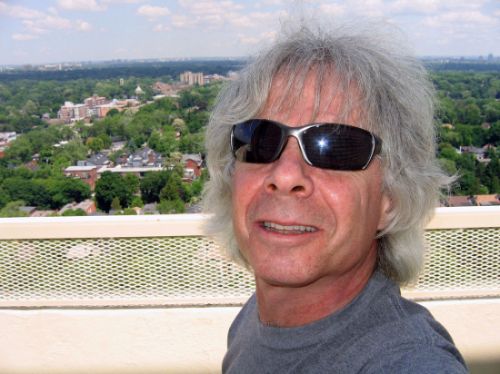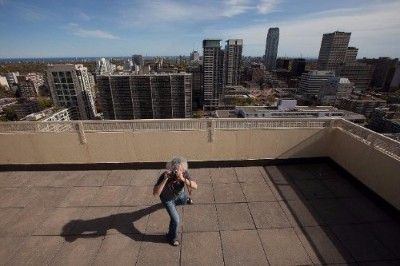One Step at a Time | Own the Equinox, Day 22
September 15, 2015
by Lorne Marin
Lorne Marin lives in Toronto, Ontario. Shortly after being diagnosed with retinitis pigmentosa in 1971, he began working as an independent filmmaker. Over the course of his career, Lorne has worked as a web developer, innkeeper, teacher, hand weaver, residential supervisor of a provincial Adjustment to Blindness program, as well as intervenor for a deafblind person. The latter two positions were a full two decades behind him when he was finally diagnosed with Usher syndrome Type 3. This diagnosis came thirty years after being declared legally blind. Early diagnosis is critical.
FOREWORD: February 1971: “It’s not a big deal. I just can’t drive.”
Unlike Raymond Babbit in the film Rain Man, I was far from an excellent driver. As a child, I had been active in sports and had never worn glasses. Looking back, however, I can recognize the obvious signs of early visual (and hearing) impairment. Someone recently told me that, upon first meeting me at the age of eleven, half a century ago, she had watched me playing with the other kids, and recalls thinking to herself, “How could he possibly not see that?”
Soon after my 16th birthday, I passed the tests to obtain a learner’s permit. I took lessons for six weeks with a driving instructor who looked concerned much of the time. Though there were a few obvious red flags that neither of us made a big enough deal about, he thought I was ready to take the road test. Word on the street was that if the examiner didn’t ask you to parallel park, you were in. He didn’t and I passed.
My memories of my few short months on the road are not characterized by freedom and independence, but rather, by fear and anxiety. My friends were afraid to be in a car with me but said nothing. One frigid winter night, upon arriving at a friend’s house to drive him downtown, he insisted that we take public transit. Then one evening, while making a right turn through a pedestrian crossing, I nearly ran over a man. I didn’t tell my parents about the incident, but did finally ask my mother to make an appointment with the family eye doctor. I drove to the appointment. She drove home.
The ophthalmologist’s assistant performed acuity tests (20/20) and began the visual field test, instructing me to look straight ahead and tell her when I first saw the test target. She said it several times. She asked once more and left the room saying, “I better get the doctor.”
The doctor performed a more comprehensive field test but said nothing. He dilated my eyes and we all chatted as the dilating drops took effect. He saw evidence of the pigment characteristic of RP. My field of vision was slightly under 20 degrees and I was legally blind. He had to take away my license or risk losing his.
I was screened for Usher two years later, and though the tests indicated a mild to moderate hearing loss, the gene responsible for USH3 wouldn't be discovered for 22 years. I was legally blind and had lousy hearing. The otolaryngologist told me I had the hearing of a 40 year old woman.
FLASH FORWARD: May 2010: “It’s a bigger deal than I thought it was. ”
With USH3, the loss of both visual and auditory function is progressive. Moira Shea described the visual loss process of RP as being like falling down a series of cliffs. In my case, serial audiograms show that my hearing loss has paralleled the gradual decline of visual function. Even small quantitative changes in either can result in much larger qualitative consequences. It feels more like going blind again than it does becoming more blind.
In 2009, in a Congressional briefing to highlight the urgency for Deaf-Blind research, Bill Kimberling explained that the combined impact of hearing and vision loss is many times greater than deafness or blindness alone. “Deafness and blindness together is not like 1+1 = 2. It’s like 1+1 = 10. Usher syndrome is a vicious disease.”
But there has never been a better time, nor brighter future, for the estimated 400,000 people worldwide who live with Usher syndrome. I have to constrain my hope because of my age. My maternal grandparents were born the same year as Helen Keller — in 1880. A third of a century before Dr. Charles Usher’s study of 69 individuals experiencing both deafness and the visual symptoms of RP. I was born only forty years later.
CLIMBING STAIRS: JUNE 2014: “I don’t always like climbing. I always like having climbed.”
I started climbing five years ago. It had become increasingly difficult to move through busy urban environments independently and I found myself going out less. Long walks that had once been nurturing, reducing stress, now increased it. In the stairwells I found something that would not only benefit vision health, but mental health as well. The first stair is six steps from my front door. The first trip up is almost always the hardest.
The building is 23 floors from my apartment to the top and has stairwells at the east and west ends. The hallways are 200 feet long. I couldn’t do it without the hallway crossovers. I estimate that I will walk close to four miles of hallway on Saturday. Climbing is the struggle, the cliffs; the hallways are the plateaus, periods of stability and recovery. On an average climb, I walk up 4 to 8 flights, cross the 200 foot hallway, and continue up until I reach the top. I take the elevator down, refuel in my apartment, and begin the next ascent.
My eyes are closed when I climb. I open them to locate handrails and doorknobs. One hand is always in contact with the handrail, one foot on the floor.
I first thought of climbing 528 flights, 5280 feet or a mile, the first time I was able to complete ten ascents. I needed a good reason, good timing and some luck to make all the pieces fit together for the first Usher Syndrome Awareness Day on Saturday. I’ve climbed the building 20 times (only once) and will have to add three more when I join the real marathoners in spirit to usher in (sorry) the first Usher Syndrome Awareness Day.
I’m so pleased to be participating in this first one. Please take time to look around the USC website — the blogs, presentations, conference call notes and, if you have Usher syndrome or someone in your family does, please take a minute to check out both the Family Network and the Usher Syndrome Registry.
Help us Own the Equinox for the hundreds of thousands of families worldwide who live with Usher syndrome. Together, we can make Usher syndrome history. #USHEQX
Learn more Usher Syndrome Awareness Day and how you can Own the Equinox.









